For the 2025 school year, there are 2 public preschools serving 946 students in Clay County School District. This district's average pre testing ranking is 6/10, which is in the top 50% of public pre schools in Alabama.
Public Preschools in Clay County School District have an average math proficiency score of 30% (versus the Alabama public pre school average of 31%), and reading proficiency score of 48% (versus the 49% statewide average).
Minority enrollment is 31% of the student body (majority Black), which is less than the Alabama public preschool average of 48% (majority Black).
Overview
This School District
This State (AL)
# Schools
5 Schools
648 Schools
# Students
1,776 Students
310,670 Students
# Teachers
106 Teachers
18,546 Teachers
Student : Teacher Ratio
17:1
17:1
District Rank
Clay County School District, which is ranked within the bottom 50% of all 145 school districts in Alabama (based off of combined math and reading proficiency testing data) for the 2021-2022 school year.
The school district's graduation rate of 80-84% has decreased from 90-94% over five school years.
Overall District Rank
#82 out of 145 school districts
(Bottom 50%)
(Bottom 50%)

Math Test Scores (% Proficient)
22%
29%
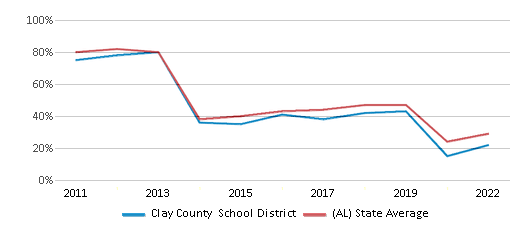
Reading/Language Arts Test Scores (% Proficient)
42%
47%
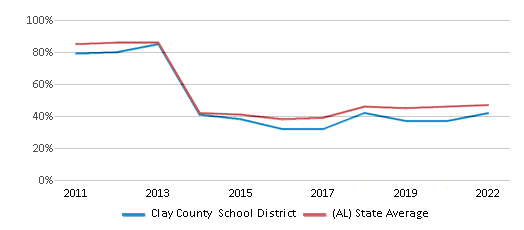
Science Test Scores (% Proficient)
33%
38%
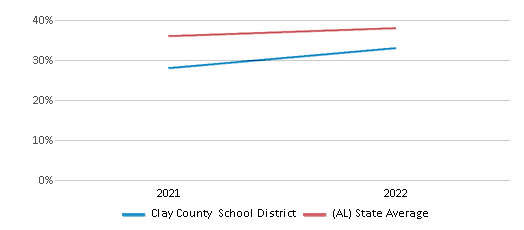
Graduation Rate
80-84%
88%
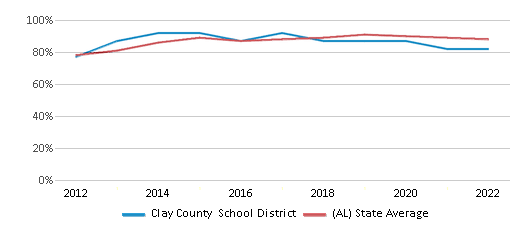
Students by Ethnicity:
Diversity Score
0.49
0.63
# American Indian Students
3 Students
3,275 Students
% American Indian Students
n/a
1%
# Asian Students
4 Students
3,474 Students
% Asian Students
n/a
1%
# Hispanic Students
105 Students
33,026 Students
% Hispanic Students
6%
11%
# Black Students
310 Students
93,822 Students
% Black Students
18%
30%
# White Students
1,224 Students
162,634 Students
% White Students
69%
52%
# Hawaiian Students
1 Student
315 Students
% Hawaiian Students
n/a
n/a
# Two or more races Students
129 Students
14,124 Students
% of Two or more races Students
7%
5%
Students by Grade:
# Students in PK Grade:
-
21,304
# Students in K Grade:
155
49,720
# Students in 1st Grade:
153
50,373
# Students in 2nd Grade:
131
48,594
# Students in 3rd Grade:
118
40,410
# Students in 4th Grade:
133
36,751
# Students in 5th Grade:
110
31,378
# Students in 6th Grade:
146
12,553
# Students in 7th Grade:
141
4,421
# Students in 8th Grade:
143
4,401
# Students in 9th Grade:
151
2,950
# Students in 10th Grade:
150
2,768
# Students in 11th Grade:
126
2,555
# Students in 12th Grade:
119
2,492
# Ungraded Students:
-
-
District Revenue and Spending
The revenue/student of $11,788 in this school district is less than the state median of $13,006. The school district revenue/student has stayed relatively flat over four school years.
The school district's spending/student of $11,056 is less than the state median of $12,220. The school district spending/student has stayed relatively flat over four school years.
Total Revenue
$21 MM
$9,671 MM
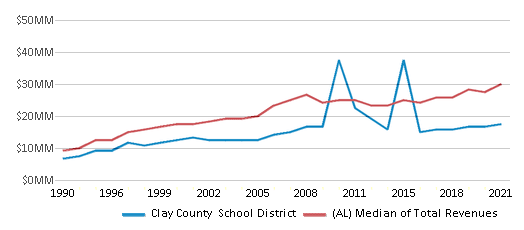
Spending
$20 MM
$9,086 MM
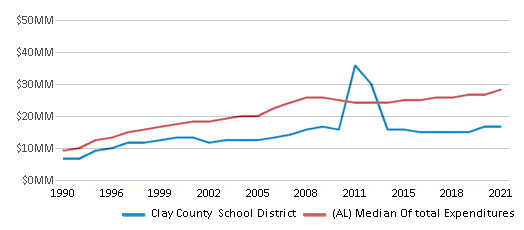
Revenue / Student
$11,788
$13,006
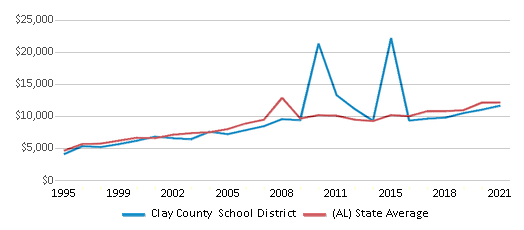
Spending / Student
$11,056
$12,220
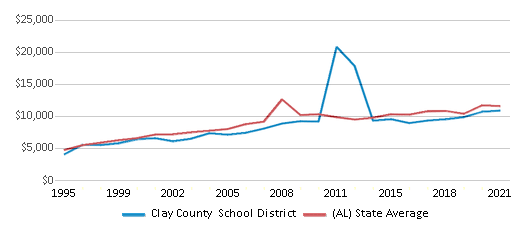
Best Clay County School District Public Preschools (2025)
School
(Math and Reading Proficiency)
(Math and Reading Proficiency)
Location
Grades
Students
Rank: #11.
Lineville Elementary School
(Math: 36% | Reading: 52%)
Rank:
Rank:
8/
Top 30%10
18 West Main
Lineville, AL 36266
(256) 396-1420
Lineville, AL 36266
(256) 396-1420
Grades: PK-6
| 477 students
Rank: #22.
Ashland Elementary School
(Math: 24% | Reading: 43%)
Rank:
Rank:
6/
Top 50%10
223 3rd Street Sw
Ashland, AL 36251
(256) 396-1466
Ashland, AL 36251
(256) 396-1466
Grades: PK-6
| 469 students
Recent Articles

Sexual Harassment at Age 6: The Tale of a First Grade Suspension
A six-year old in Aurora, Colorado, was suspended after singing an LMFAO song to a little girl in his class and reportedly “shaking his booty.” We look at the case and the sexual harassment problem in public schools today.

How Scaffolding Could Change the Way Your Child Learns
This article explores the concept of instructional scaffolding, a teaching method that enhances learning by breaking down complex tasks into manageable parts. It highlights how scaffolding supports students in developing critical thinking skills and becoming more independent learners. The article discusses the benefits of scaffolding, including improved engagement and reduced anxiety, and provides strategies for its implementation across various educational levels.

February 05, 2025
Understanding the U.S. Department of Education: Structure, Impact, and EvolutionWe explore how the Department of Education shapes American education, from its cabinet-level leadership to its impact on millions of students, written for general audiences seeking clarity on this vital institution.





